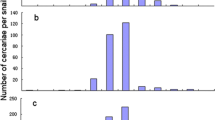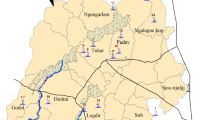Abstract
Schistosomiasis japonicum is one of the most serious communicable diseases, and the transmission of the parasite is dependent of its complex life cycle on which many factors can have an impact. Multiple infections comprising both male and female schistosome within snail intermediate hosts, for example, would facilitate parasite transmission. However, no research on Schistosoma japonicum communities in field-collected Oncomelania hupensis hupensis in relation to schistosome sex has been reported. Therefore, snail survey was performed in a hilly region of Anhui, China, and single- or mixed-sex schistosome infections of snails were detected with final host mouse infection. A total of 8,563 snails were sampled in the field, and 67 were identified with schistosome infections. Of these infected snails, 46 were selected for final host infection. From this, 21 snails were infected with female schistosome, 23 with males and 2 with both males and females. More worms were recovered for snails with mixed-sex infections than with single-sex infection and for snails with male schistosome infection than with female infection (P < 0.001). The observed frequency of mixed-sex infections of snails was significantly higher than would be expected if randomly distributed (P < 0.01). The ratio male/female of schistosome infections in snails was nearly equal and up to 95.65 % (44/46) of infected snails were single-sex infection. Schistosome infections in snails collected from the hilly area of Anhui Province were not randomly distributed but over-dispersed.


Similar content being viewed by others
References
Balmer O, Tanner M (2011) Prevalence and implications of multiple-strain infections. Lancet Infect Dis 11(11):868–878
Beltran S, Boissier J (2009) Male-biased sex ratio: why and what consequences for the genus Schistosoma? Trends Parasitol 26(2):63–69
Boissier J, Morand S, Mone H (1999) A review of performance and pathogenicity of male and female Schistosoma mansoni during the life-cycle. Parasitology 119(Pt 5):447–454
Boissier J, Rivera ER, Mone H (2003) Altered behavior of the snail Biomphalaria glabrata as a result of infection with Schistosoma mansoni. J Parasitol 89(3):429–433
Chandiwana SK, Taylor P, Clarke VD (1988) Prevalence and intensity of schistosomiasis in two rural areas in Zimbabwe and their relationship to village location and snail infection rates. Ann Trop Med Parasitol 82:163–173
Cheever AW, Lewis FA, Wynn TA (1997) Schistosoma mansoni: unisexual infections sensitized mice for granuloma formation around intravenously injected eggs. Parasitol Res 83(1):57–59
Dabo A, Durand P, Morand S, Diakite M, Langand J, Imbert-Establet D, Doumbo O, Jourdane J (1997) Distribution and genetic diversity of Schistosoma haematobium within its bulinid intermediate hosts in Mali. Acta Trop 66:15–26
Dumont M, Mone H, Mouahid G, Idris MA, Shaban M, Boissier J (2007) Influence of pattern of exposure, parasite genetic diversity and sex on the degree of protection against reinfection with Schistosoma mansoni. Parasitol Res 101(2):247–252
Eppert A, Lewis FA, Grzywacz C, Coura-Filho P, Caldas I, Minchella DJ (2002) Distribution of schistosome infections in molluscan hosts at different levels of parasite prevalence. J Parasitol 88(2):232–236
Jiang YJ, Xi WP, Sun QQ (1997) The observation of mixed mud fodder for snail raising. Chin J Schistoso Control 1:46–47
Jones-Nelson O, Thiele EA, Minchella DJ (2011) Transmission dynamics of two strains of Schistosoma mansoni utilizing novel intermediate and definitive hosts. Parasitol Res 109(3):675–687
Jourdane J (1980) Distribution binomiale des probabilites d’infestation du mollusque dans le couple: Schistosoma mansoni-Biomphalaria glabrata. Haliotis 10:74
Kristt AC, Lively CM, Levri EP, Jokela J (2000) Spatial variation in susceptibility to infection in a snail-trematode interaction. Parasitology 121(Pt 4):395–401
Lu DB, Rudge JW, Wang TP, Donnelly CA, Fang GR, Webster JP (2010a) Transmission of Schistosoma japonicum in marshland and hilly regions of China: parasite population genetic and sibship structure. PLoS Negl Trop Dis 4(8):e781
Lu DB, Wang TP, Rudge JW, Donnelly CA, Fang GR, Webster JP (2010b) Contrasting reservoirs for Schistosoma japonicum between marshland and hilly regions in Anhui, China—a two-year longitudinal parasitological survey. Parasitology 137:99–110
Lu DB, Wang TP, Rudge JW, Donnelly CA, Fang GR, Webster JP (2011) Genetic diversity of Schistosoma japonicum miracidia from individual rodent hosts. Int J Parasitol 41(13–14):1371–1376
Manning SD, Woolhouse ME, Ndamba J (1995) Geographic compatibility of the freshwater snail Bulinus globosus and schistosomes from the Zimbabwe highveld. Int J Parasitol 25(1):37–42
Mao SP (1990) Schistosome biology and control of schistosomiasis. Publishing House of People’s Health, Beijing
McManus DP, Li Y, Gray DJ, Ross AG (2009) Conquering ‘snail fever’: schistosomiasis and its control in China. Expert Rev Anti Infect Ther 7(4):473–485
Minchella DJ, Sollenberger KM, Pereira de Souza C (1995) Distribution of schistosome genetic diversity within molluscan intermediate hosts. Parasitology 111:217–220
Morand S, Manning SD, Woolhouse MEJ (1996) Parasite-host coevolution and geographic patterns of parasite infectivity and host susceptibility. Proc R Soc Lond B 263:119–128
Moukrim A, Zekhnini A, Rondelaud D (1996) Schistosoma haematobium: influence of the number of miracidia on several characteristics of infection in newborn Planorbarius metidjensis. Parasitol Res 82(3):267–269
Qiu LS, Zhang YH, Chen W, Li H, Xue HC (1994) Relationship between the sex of Schistosoma japonicum and circulating antigen detection. Chin J Parasitol Parasit Dis 12(3):221–222
Richards CS (1975) Genetic studies of pathologic conditions and susceptibility to infection in Biomphalaria glabrata. Ann NY Acad Sci 266:394–410
Sire C, Durand P, Pointier JP, Theron A (1999) Genetic diversity and recruitment pattern of Schistosoma mansoni in a Biomphalaria glabrata snail population: a field study using random-amplified polymorphic DNA markers. J Parasitol 85(3):436–441
Sorensen E, Johansen MV, Wilson S, Bogh HO (1999) Elucidation of Schistosoma japonicum population dynamics in pigs using PCR-based identification of individuals representing distinct cohorts. Int J Parasitol 29(12):1907–1915
Steinauer ML, Mwangi IN, Maina GM, Kinuthia JM, Mutuku MW, Agola EL, Mungai B, Mkoji GM, Loker ES (2008) Interactions between natural populations of human and rodent schistosomes in the Lake Victoria region of Kenya: a molecular epidemiological approach. PLoS Negl Trop Dis 2(4):e222
Utzinger J, Zhou XN, Chen MG, Bergquist R (2005) Conquering schistosomiasis in China: the long march. Acta Trop 96(2–3):69–96
Webster JP, Davies CM, Hoffman JI, Ndamba J, Noble LR, Woolhouse ME (2001) Population genetics of the schistosome intermediate host Biomphalaria pfeifferi in the Zimbabwean highveld: implications for co-evolutionary theory. Ann Trop Med Parasitol 95(2):203–214
Woolhouse ME, Chandiwana SK, Bradley M (1990) On the distribution of schistosome infections among host snails. Int J Parasitol 20(3):325–327
Woolhouse ME, Etard JF, Dietz K, Ndhlovu PD, Chandiwana SK (1998) Heterogeneities in schistosome transmission dynamics and control. Parasitology 117:475–482
Acknowledgments
This work was funded by the National Training Programs of Innovation and Entrepreneurship for Undergraduates (2013), the National Sciences Foundation of China (no. 81273141) and the Priority Academic Program Development of Jiangsu Higher Education Institutions (PAPD).
Ethical standards
The experiments comply with the current laws of China.
Conflict of interest
The authors declare that they have no competing interests.
Author information
Authors and Affiliations
Corresponding author
Electronic supplementary material
Below is the link to the electronic supplementary material.
Online Resource 1
(PDF 57 kb)
Rights and permissions
About this article
Cite this article
Shi, HP., Lu, DB., Shen, L. et al. Single- or mixed-sex Schistosoma japonicum infections of intermediate host snails in hilly areas of Anhui, China. Parasitol Res 113, 717–721 (2014). https://doi.org/10.1007/s00436-013-3700-0
Received:
Accepted:
Published:
Issue Date:
DOI: https://doi.org/10.1007/s00436-013-3700-0




